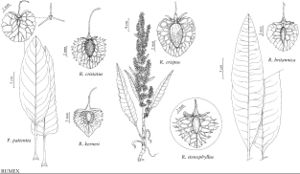Rumex crispus
Sp. Pl. 1: 335. 1753.
Plants perennial, occasionally biennial, glabrous or very indistinctly papillose normally only on veins of leaf blades abaxially, with fusiform, vertical rootstock. Stems erect, branched distal to middle, 40–100(–150) cm. Leaves: ocrea deciduous, rarely partially persistent at maturity; blade lanceolate to narrowly lanceolate or lanceolate-linear, normally 15–30(–35) × 2–6 cm, base cuneate, truncate, or weakly cordate, margins entire to subentire, strongly crisped and undulate, apex acute. Inflorescences terminal, occupying distal 1/2 of stem, dense or interrupted at base, narrowly to broadly paniculate, branches usually straight or arcuate. Pedicels articulated in proximal 1/3, filiform, (3–)4–8 mm, articulation distinctly swollen. Flowers 10–25 in whorls; inner tepals orbiculate-ovate or ovate-deltoid, 3.5–6 × 3–5 mm, base truncate or subcordate, margins entire or subentire to very weakly erose, flat, apex obtuse or subacute; tubercles normally 3, rarely 1 or 2, unequal, at least 1 distinctly larger, more than (1–)1.5 mm wide. Achenes usually reddish brown, 2–3 × 1.5–2 mm. 2n = 60.
Phenology: Flowering late spring–early fall.
Habitat: Very broad range of ruderal, segetal, and seminatural habitats, disturbed soil, waste places, cultivated fields, roadsides, meadows, shores of water bodies, edges of woods
Elevation: 0-2500 m
Distribution

Introduced; St. Pierre and Miquelon, Alta., B.C., Man., N.B., Nfld. and Labr. (Nfld.), N.W.T., N.S., Ont., P.E.I., Que., Sask., Yukon, Ala., Alaska, Ariz., Ark., Calif., Colo., Conn., Del., D.C., Fla., Ga., Idaho, Ill., Ind., Iowa, Kans., Ky., La., Maine, Md., Mass., Mich., Minn., Miss., Mo., Mont., Nebr., Nev., N.H., N.J., N.Mex., N.Y., N.C., N.Dak., Ohio, Okla., Oreg., Pa., R.I., S.C., S.Dak., Tenn., Tex., Utah, Vt., Va., Wash., W.Va., Wis., Wyo., Eurasia, introduced almost worldwide.
Discussion
Rumex crispus (belonging to subsect. Crispi Rechinger f.; see K. H. Rechinger 1937) is the most widespread and ecologically successful species of the genus, occuring almost worldwide as a completely naturalized and sometimes invasive alien. It has not been reported from Greenland, but it probably occurs there.
Rumex crispus hybridizes with many other species of subg. Rumex. Hybrids with R. obtusifolius (Rumex ×pratensis Mertens & Koch) are the most common in the genus, at least in Europe, and have been reported for several localities in North America. Rumex crispus × R. patientia (Rumex ×confusus Simonkai) was reported from New York. According to R. S. Mitchell (1986, p. 47), “this hybrid is now spreading along highway shoulders, and it has replaced R. crispus in some local areas.” However, that information should be confirmed by more detailed studies since spontaneous hybrids between species of sect. Rumex usually are much less fertile and ecologically successful than the parental species. Hybrids of Rumex occuring in North America need careful revision.
Numerous infraspecific taxa and even segregate species have been described in the Rumex crispus aggregate. Many seem to represent minor variation of little or no taxonomic significance, but some are geographically delimited entities that may deserve recognition as subspecies or varieties. The typical variety has inner tepals with three well-developed tubercles; the less common var. unicallosus Petermann, with one tubercle, occurs sporadically in North America.
Some eastern Asian plants differ from typical Rumex crispus is having somewhat smaller inner tepals, longer pedicels, lax inflorescences with remote whorls, and narrower leaves that are almost flat or indistinctly undulate at the margins. These plants, originally described as R. fauriei Rechinger f., are now treated as R. crispus subsp. fauriei (Rechinger f.) Mosyakin & W. L. Wagner; the subspecies was recently reported from Hawaii (S. L. Mosyakin and W. L. Wagner 1998) and may be expected as introduced in western North America.
Selected References
None.
